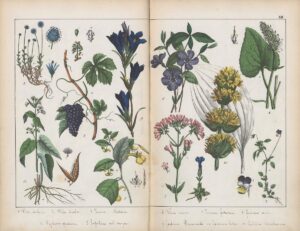
In English this natural depiction of plants is called ‘botanical art’, and it is in England that the tradition of this art form developed. This is hardly surprising given that in the 18th and 19th centuries it was mainly English ‘plant hunters’ that sought, collected and transported plant specimens from all four corners of the globe on behalf of patrons besotted by gardens, parks and exotic plants.

Once these unknown plants reached England, the next job was to ensure that they were scientifically classified. The creation of precise drawings capturing the tiniest detail of these plants therefore became an increasingly key component of the process. And it is from this need that ‘botanical art’ as a distinct art form developed, and which subsequently attracted so many devotees mainly in England. So much so that today, clubs and
exhibitions are organised in most every English town or city.
And it is also in the UK where the biggest event for Botanical Art worldwide takes place. Each year the “Society of Botanical Artist” organises and invites artist to exhibit their exquisite work for five days at the Mall Galleries in London.
But drawings of plants have naturally existed for a much longer time, such as those depicted in Egyptian temples and tombs and depictions in books that have survived from antiquity and the middle ages. The most famous are the drawings from Maria Sybilla Merian, and the botanical watercolours of Georg Dionysius Ehret, Pierre-Joseph Redouté and from the brothers Franz and Ferdinand Bauer. Even Leonardo da Vinci and Albrecht Dürer produced very detailed studies of plants which they captured on canvas.
Botanical art, or ‘Botanische Illustration’ in German, has long since departed from its early scientific function, but still holds true to its original purpose of creating an exact representation of a plant in its tiniest detail. Contemporary botanical illustrators still strive to understand the very essence and nature of a plant through their drawings and watercolours. They consider it of the utmost importance to capture the beauty, character and uniqueness of the subject in art form.
It goes without saying therefore that very high artistic demands are placed on botanical artists, who must possess extremely good powers of observation and drawing skills. Artistic freedom would seemingly appear to be very constrained in the strictest sense of this art form, and yet each artist still manages to stamp his or her own individuality on their work.
In Germany, botanical art is still very much a niche art form so I consider it my goal to raise the awareness of it, and to attract a broader circle of fans, followers and people who derive pleasure from the beauty of painted plants.